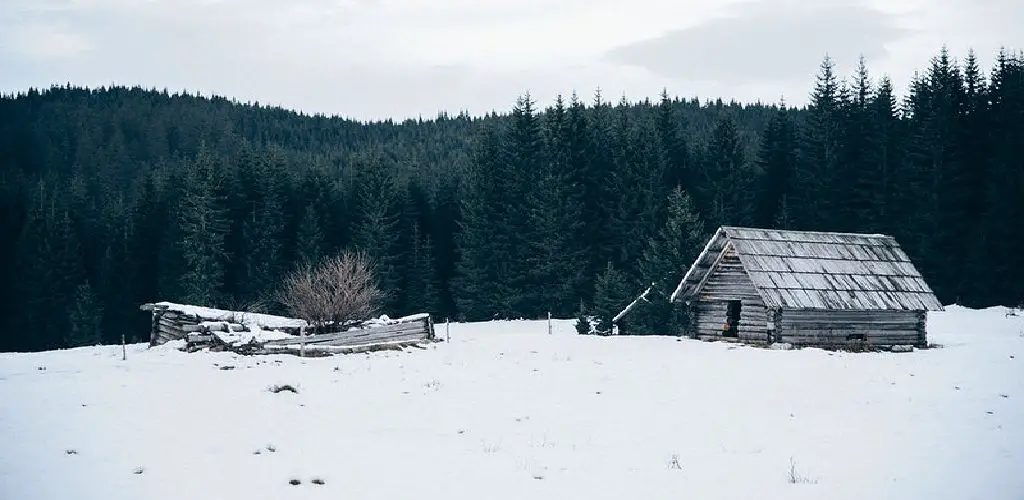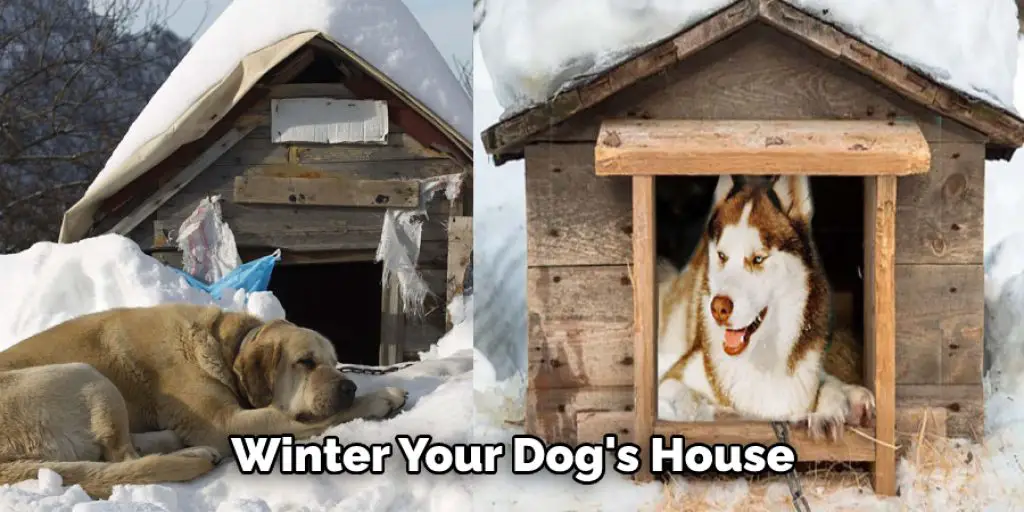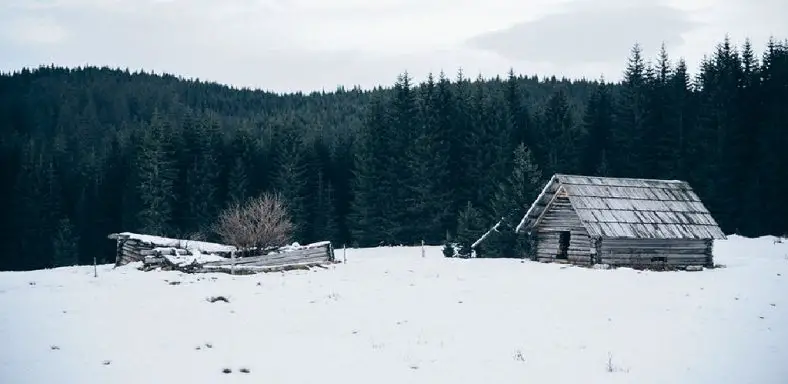If you are like most dog owners, your furry friend spends at least some time outside during the winter. But if you don’t take steps to winterize your dog house, your pet could suffer from the cold weather. In this blog post, we will show you how to winterize dog house so that your pet can stay warm and safe all winter long.

Contents
Why it’s important to winterize dog houses?
There are a few reasons why it’s important to winterize your dog house. First of all, if you don’t take steps to winterize your dog’s house, your pet could suffer from the cold weather. In addition, if your dog’s house isn’t winterized properly, it could become wet and moldy, which would be bad for your pet’s health. Finally, if you don’t winterize your dog house, your pet could become very cold and even develop frostbite.
Required Materials
To Winterize Your Dog’s House, You Will Need the Following Materials:
- Insulation
- Tarps
- Straw
- Nails or screws
- Drill
- Broom
A Stepwise Guide on How to Winterize Dog House
Step 1: Clean It Out:
The first step is to clean the dog house thoroughly. Next, get rid of any old straw, leaves, or other debris that might be in there. This will help keep your dog’s house clean, dry, and free from pests during the winter.
Then, Mix a solution of bleach and water in a ratio of 1 part bleach to 10 parts water. Use this solution to clean the dog house again, making sure to get into all the nooks and crannies. This will help kill any pests or bacteria present and help disinfect the house. Let the house dry completely before moving on to the next step.
Step 2: Assess Its Structure and Location:
Before you do anything else, you’ll need to assess the structure and location of your dog’s house. Ensure that it is in a sheltered spot where the wind will not buffet it. If it is not structurally sound, you may need to reinforce it with some additional lumber or insulation.

Further, minimize the wind’s effects by adding a windbreak around the house. You can use a fence, a hedge, or even heavy objects like rocks or bricks. Ensure that the windbreak is tall enough to deflect the wind away from the house.
If the dog house needs to be moved, use a dolly or another wheeled vehicle to transport it. Dragging the house across the ground will only damage it and might injure your dog.
Once you have placed the house in its new location, you may need to add some additional insulation. If your dog’s house is not well-insulated, it could get very cold during the winter months. You can use straw, newspapers, or even foam insulation to keep your pet warm and comfortable.
Step 3: Elevate It off the Ground:
Elevating your dog’s house off the ground will help keep it warm and dry. If you can, put it on a raised platform or a set of cinder blocks. This will help to prevent moisture from seeping in and causing damage.
Do a quick check of the yard and note areas where you might need to add some additional insulation. If your dog’s house is not well-insulated, it could get very cold during the winter months. You can use straw, newspapers, or even foam insulation to keep your pet warm and comfortable.
You can place the dog house on a waterproof platform for added support. This will help to keep the house dry and free from moisture damage. You can use a wooden platform, a plastic platform, or even a concrete slab. Just make sure that it is level and stable.
If you live in a very cold climate, you may want to consider adding a heating pad or some other type of heating device to the house. This will keep your dog warm and comfortable even during the coldest weather.
Step 4: Add Insulation:
Adding insulation is key to winterizing your dog’s house. There are a few different options, but the most popular is fiberglass batting. Add a layer or two of the batting to the inside of the house. This will help keep your dog warm and cozy all winter long.

Step 5: Add a Heater:
If you live in a cold climate, you’ll want to add a heater to your dog’s house. This will help keep her warm even on the coldest days. Be sure to choose a safe heater for pets and follow all the instructions carefully.
Step 6: Protect Against Cold and Moisture:
To protect your dog’s house against the cold and moisture, you’ll need to add a weatherproof cover. This can be a simple tarp or a more specialized piece of equipment like a dog house cover. Either way, make sure that it is water-resistant and will keep the elements out.
Seal up any holes or cracks in the house with spray insulation or waterproof caulking. This will help keep out the cold and moisture and will help to keep your dog warm and comfortable all winter long.
Step 7: Add Heaters for Comfort:
Finally, consider adding a few small heaters to your dog’s house for extra comfort. This is especially important if your dog likes to spend a lot of time inside her house. A few small heaters will help to keep her warm and snug all winter long.
Follow these steps, and you’ll be able to keep your furry friend warm and comfortable all winter long! Keep reading for more information about how to winterize dog house.
How Can I Heat My Dog House without Electricity?
There are many ways to heat your dog’s house without electricity. If you have a kerosene heater, this is a great option. You can also use a propane heater, but make sure it is approved for indoor use.
If you have a wood-burning stove, this is another great option. Just keep the dog house a safe distance from the stove. You can also use a heating pad, but make sure that it is unplugged when you are not home.
The Process to Follow on:
- Inspect the house for any cracks or holes that need to be repaired
- Add insulation if necessary
- Seal any cracks or holes with caulk or weatherstripping
- Place a heater inside the house (if using an electric heater, be sure to use a surge protector)
- Make sure there is plenty of fresh water and food available
- Check the house regularly to make sure that it is warm and dry

Frequently Asked Question
What Can You Put in A Dog House to Keep It Warm in Winter?
You can put a few things in a dog house to keep it warm in winter. You can put hay or straw inside to help insulate the space, and you can also hang a blanket or tarp over the opening to keep out the wind and cold. If your dog has a bed, you can also put that inside the house to provide extra warmth.
How Do You Winterize an Outside Dog Kennel?
If your dog lives in an outdoor kennel, you’ll need to take extra steps to keep them warm during the winter months. One of the most important things is to make sure that the kennel is properly insulated.
You can do this by putting hay or straw inside and adding a blanket or tarp over the opening to keep out the wind and cold. If your dog has a bed, you can also put that inside the kennel to provide extra warmth.
Can a Dog Stay Outside in The Winter in A Dog House?
Many people choose to keep their dogs inside during the winter, as it can be very cold outside. However, if you choose to keep your dog in a dog house outside, you’ll need to ensure that they are properly insulated and have a warm bed to sleep in. You’ll also need to provide adequate shelter from the wind and snow.
Is It Okay to Put Blankets in A Dog House?
Blankets, however, are not a good insulator and should not be used for this purpose. A heavy blanket will either get wet from melted snow or ice or wet from condensation in the air caused by warm air bearing down on cooler surfaces.
How Is Cold Too Cold for Dogs in A Doghouse?
There is no definitive answer to this question, as different dogs will tolerate different temperatures. However, most dogs will be comfortable in a dog house if the temperature is above 32 degrees Fahrenheit. If it’s colder than that, you may need to provide extra insulation or bring your dog inside.

What Can I Do if My Neighbor Leaves My Dog in The Cold?
If you’re concerned that your neighbor is leaving their dog in the cold, you can try talking to them about it. You may also want to contact animal control or the police if you feel the dog is in danger.
Conclusion
The dog house is a very important part of your pet’s life, and it’s important to take the time to winterize it properly so that your furry friend stays warm and safe all season long. By following these simple tips, you can be sure that your dog will be happy and healthy no matter how cold it gets outside. Thanks for reading our post about how to winterize dog house.

